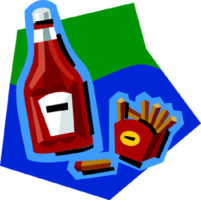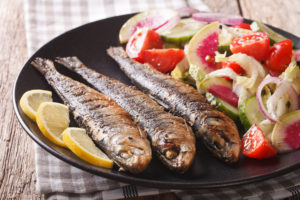 October 11, 2017
October 11, 2017
Days Until. . .
Halloween: 20 Thanksgiving (Nov. 22): 43
Today's Flavor
It's appropriate that, right in the middle of Oktoberfest, this should be Schnitzel Day. A schnitzel is a piece of meat that has been pounded thin, and then cooked. Usually it's breaded and sizzled in a pan of hot oil, along the same lines as our familiar pannee meat, but with a lighter breading and less seasoning. It's not certain where schnitzels originated. The most credible history has it first in Alpine Italy, from which it spread to Austria, then to Germany. The original schnitzels were made not with veal, but pork--which makes sense. (I much prefer pork cooked this way to veal.) The most famous of the schnitzels is Wiener schnitzel--or, as some restaurants have it, Vienna schnitzel, in honor of the place from which it came. It's simple, with a scattering of capers and a spritz of lemon juice. One I always liked was Holsteiner schnitzel--the same idea, but with a fried egg on top.
The Old Kitchen Sage Sez:
The best veal medallions (scaloppine, schnitzel, collops, etc.) are cut from the round across the grain. It's astonishing how many meatcutters don't seem to know that veal cut along the natural orientation of the muscle tissues is anything but tender.
Edible Dictionary
oyster sauce, n.,--A prepared sauce found in bottles in the Asian section of the supermarket. It's dark brown and very thick, spreadable but not pourable. A staple of Chinese cooking oyster sauce is made with actual oysters, soy sauce, salt, sugar, and water. It's used to flavor and darken Chinese sauces. One story has it that a cook making an oyster soup forgot that it was on the fire, and when he checked the pot he found a thick, dark sludge. He bravely tasted it and liked the flavor, and started making it on purpose. Oyster sauce has been used in Chinese cooking since the latter 1800s.
Food Entrepreneurs
 Today is the birthday, in 1844, of Henry John Heinz, he of the fifty-seven varieties of pickles and sauces. He found his path early, raising vegetables and selling them to grocers in Pittsburgh when he was twelve. By the time he was twenty-five, he was bottling prepared horseradish--in a clear jar, so you could see what you were getting. Then on to pickles, sauerkraut, mustard, pepper sauce, and soups. But the company's biggest hit was its ketchup (they've always spelled it that way). It's the leading brand in America. Heinz still uses the "57" as a trademark, although they have plenty more varieties of products than that.
Today is the birthday, in 1844, of Henry John Heinz, he of the fifty-seven varieties of pickles and sauces. He found his path early, raising vegetables and selling them to grocers in Pittsburgh when he was twelve. By the time he was twenty-five, he was bottling prepared horseradish--in a clear jar, so you could see what you were getting. Then on to pickles, sauerkraut, mustard, pepper sauce, and soups. But the company's biggest hit was its ketchup (they've always spelled it that way). It's the leading brand in America. Heinz still uses the "57" as a trademark, although they have plenty more varieties of products than that.
Food Inventors
William A. Mitchell, a food chemist working for General Foods, created some of the most successful products in food marketing history. Tang, for example. A powder that you mixed with water to make a drink that tasted vaguely like orange juice, it actually replaced juice for a lot of people, who considered it (as we say around New Orleans) "modren." Who drinks it now? Mitchell patented Pop Rocks candy in the 1950s, but had to wait until the 1970s to see it explode--literally. Pop Rocks contain bubbles of pressurized carbon dioxide, and they pop when the candy dissolves in your mouth. His next hit was Cool Whip, the non-dairy whipped cream substitute, sold in a plastic bowl with a tight-fitting lid. Many containers of Cool Whip were no doubt bought for the container. I wonder whether Mitchell made anything that was real or tasted good. Well, you can't knock his success--seventy patents. Mitchell was born today in 1911.
Gourmet Gazetteer
 sardine, n.--Sardines--named for the island of Sardinia--are a treat we sometimes see in New Orleans, particularly around St. Joseph's Day. They're six to eight inches long, pan-sauteed or broiled, and served whole. They have a very assertive flavor that will not please those who complain about fish tasting "fishy." For those with more adventuresome palates, they're a delight. They brought in from the Mediterranean Sea, which is their natural habitat. For that reason, we don't find them on many restaurant menus. The New Orleans restaurant most likely to have fresh sardines is Andrea's, but on occasion a chef will bring them in to mess around with for his gourmet customers.
sardine, n.--Sardines--named for the island of Sardinia--are a treat we sometimes see in New Orleans, particularly around St. Joseph's Day. They're six to eight inches long, pan-sauteed or broiled, and served whole. They have a very assertive flavor that will not please those who complain about fish tasting "fishy." For those with more adventuresome palates, they're a delight. They brought in from the Mediterranean Sea, which is their natural habitat. For that reason, we don't find them on many restaurant menus. The New Orleans restaurant most likely to have fresh sardines is Andrea's, but on occasion a chef will bring them in to mess around with for his gourmet customers.
Food In History?
This sounds like a food-related event, but wasn't. Today in 1922, Turkey and Greece called a cease-fire, bringing to an end one of the final tiffs of World War I.
Annals Of Chefs Gone Nuts
In 1999 in Paris on this day, chefs incensed about a twenty-percent tax on restaurant meals rioted. Things got nasty enough that it had to be quelled with tear gas. The chefs' weapons? Eggs. Imagine.
Food Namesakes
Pro football player Ron Mayo was born today in 1950. . . Texas Congressman J.J. Pickle was born today in 1913. . . If only we could find someone named Ketchup and another named Mustard whose birthdays are today!
Words To Eat By
"Every man will have to give an account of himself for every good thing which he would have liked to eat, but did not."--Hillel.
Words To Drink By
"One of the disadvantages of wine is that it makes a man mistake words for thoughts."--Samuel Johnson.
 Read entire article.
Read entire article.